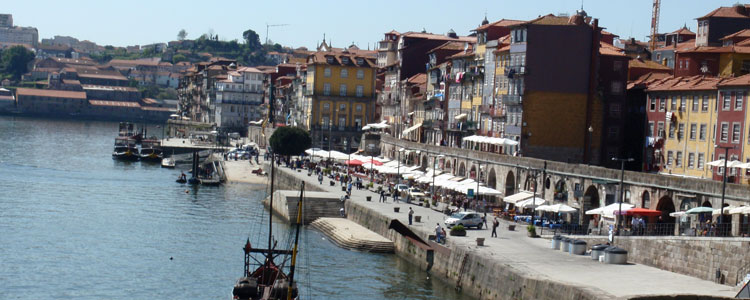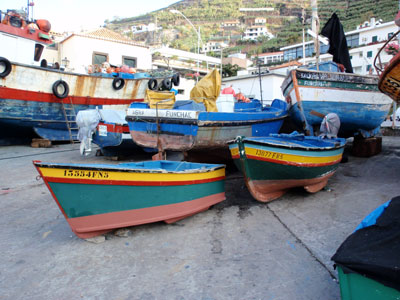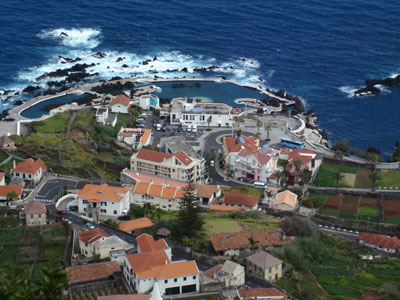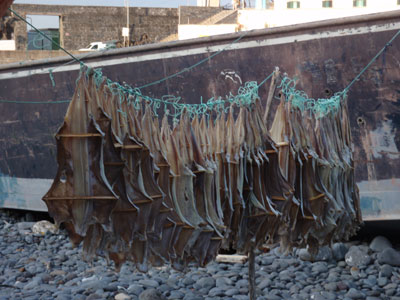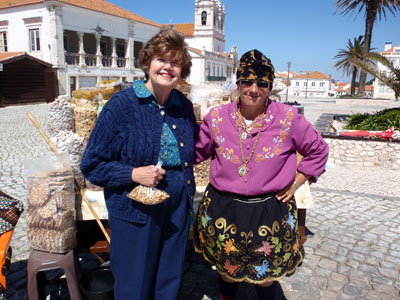Meandering through mainland Portugal and Madeira on a budget
by Jean Nethery; Blairsville, GA
March and April have always been favorite travel months for my husband, Al, and me. Before April 15, airfares are less expensive and tourist season is still at least a month away. For 2011 we chose an independent trip to Madeira and mainland Portugal (March 27-April 14).
Both places intrigued us and appeared not to be overrun by American travelers, plus my husband is an amateur wine maker and the thought of sampling regional wines appealed to us.
We chose an independent trip since we couldn’t locate a tour that offered what we wanted to see in Portugal without including Spain.
Making plans
When browsing the Internet we discovered numerous independent itineraries, but the drudgery of doing all of the planning without the help of a travel agent soon became overwhelming.
Also, the cost of a rental car and having no discounts on accommodations made the trip more expensive than we expected. Then we found Inês Leitão of Portugal Trails (Cascais, Portugal; phone +351 214 851 476 or, via Skype from the US [4 a.m. to 1 p.m. EST], 415/513-0294).
In corresponding with Inês, we found that she could obtain discounts unavailable to us. She also had firsthand knowledge of small hotels and B&Bs not found in travel books. Her assistance saved us much “footwork” and cut our costs considerably.
For the two of us, the cost for the mainland Portugal portion of our trip was $3,580. Included were a car rental with GPS and insurance; accommodations for 14 nights, with breakfasts; maps; travel guides, and restaurant recommendations.
The airport is close to Lisbon, making it worthwhile to stay overnight in the city, itself. Inês arranged for us to stay at Hotel Tivoli Oriente (phone 351 218 915 100) and included limousine service upon our arrival from the US. We hired a taxi for the 10-minute ride back to the airport the next morning to catch our 1½-hour TAP flight to Madeira, where we would spend three nights before returning to the mainland.
Beginning in Madeira
Madeira is a mountainous, subtropical paradise. Dramatic landscapes with jagged cliffs overlook the sea, while white stucco houses with red tile roofs make up the hilly, picturesque villages.
Since we enjoy local color, we decided to take the city bus from the airport to the historic area of Funchal, where our hotel was located. I found Hotel Orquídea (Rua dos Netos, 69-71, phone +351 291 200 120) on the Internet for $88 per night for two, including a full buffet breakfast.
We opted not to rent a car in Funchal, as all of the historic sites and restaurants were within walking distance of our hotel. We did take a one-hour Yellow Bus (phone +351 21 361 30 10) tour ($17) to orient ourselves. Offered in addition, at no cost, was a 1½-hour Blue Bus tour of sites outside the city. This included a drive by the famous Reid’s Palace hotel, where Winston Churchill often stayed, and the fishing village of Câmara de Lobos, which Churchill painted.
We had an exceptional meal our first night at a well-established, recommended restaurant, O Jango (Rua de Santa Maria, 166; phone 291 221 280). We ordered a popular fish dish, espada (black scabbard) with bananas, which came with a large salad and boiled local vegetables. We also ordered Bolo do Caco, the local sweet potato bread baked in a stone oven, and a bottle of vinho verde (“green” wine) from northern Portugal. Our total bill was $54, including tip.
Out and about
Following a hearty buffet breakfast, we left for a full-day tour of the western part of the island. Numerous tours were available. I recommend using a local van service rather than taking a bus. We booked the “Porto Moniz Tour” ($59.50 per person, including lunch) through our hotel.
We visited Cabo Girão, one of the highest cliffs in Europe, and the villages of Ribeiro Brava and Porto Moniz. Also included was a drive through the Encumeada mountain pass, where we experienced a walk on one of Madeira’s many levadas (hiking paths beside irrigation ditches).
The day was worthwhile. We wished we had added an extra day to our three-night stay in order to see Santana, in the northeastern part of the island, where traditional, thatched A-frame houses can still be found.
If visiting Madeira, don’t miss Funchal’s Mercado dos Lavradores, where ladies in village costume sell flowers and fishmongers chop tuna and black-skinned scabbard (fish with huge eyes and razor-sharp teeth) on slabs of marble.
Beside the market you can take the gondola up to Monte, where you can stroll through the Palace Tropical Gardens and visit the rebuilt church of Nossa Senhora do Monte.
An experience we found worth trying is sliding down Monte in a wicker basket mounted on wooden runners. Two men wearing straw hats and rubber-soled boots (used as brakes) guided us down a one-mile descent. A local bus or taxi takes you the rest of the way down.
We tried two other superb restaurants in downtown Funchal that served regional dishes — Restaurant Dos Combatentes (Rua Ivens, 1; phone 291 221 388) and Patio Restaurant (Rua da Carreira No. 43; phone 291 227 376). Check for opening times; most restaurants are closed Sundays plus one other day midweek. For two, our meal cost $55-$72 with wine and tip.
Returning to Lisbon
Upon returning to Lisbon, we stayed at the centrally located Hotel Lisboa Plaza (phone 351 213 218 218), a classy hotel with superb service and an exceptional buffet breakfast. The location was excellent — within walking distance of wonderful restaurants as well as buses, the Metro and the funicular that takes you up to Bairro Alto.
We opted to spend two days in Lisbon without a car, exploring the different areas on foot or using public transportation. We purchased an all-day pass (E11) on both of those days so we could explore the areas of Baixa, Bairro Alto and Belém.
The Gulbenkian Museum, created to house the collection bequeathed to Portugal by an Armenian oil magnate, should not be missed. The museum has one of the finest collections of art in Europe and includes works by the Great Masters, fine displays of Middle Eastern artifacts, and 18th-century French castle furniture. There is also a nice collection of Art Nouveau jewelry and hairpieces.
We’d also recommend a ride on Tram 28, a historical tramway that winds around the oldest and most typical streets of the Old Town.
In Bairro Alto, we enjoyed the quality of the food, the good service and the cost at Bota Alta (Travessa da Queimada 35-37; phone 213 427 959). Our meal ($60 with tip), included a bottle of wine, two small bottles of water, appetizers, bread and one entrée each of lamb and codfish.
Visitors need to know that when you sit down in any restaurant in Portugal, the waiter will put on the table several appetizers, along with bread. The cost for these will be added to your bill. If you don’t want any (or all) of the items, be sure to indicate that and send them back.
Many restaurants are closed on Sundays throughout Portugal. One that was open (and near our hotel) was Restaurante Marisqueira de Santa Marta (Travessa do Enviado de Inglaterra, No. 1D; phone 213 525 638). The grilled local catch of the day with vegetables, bread and a bottle of wine cost $72, including tip.
Belém
We took a bus to Belém, where we spent most of the day.
We began at the Monastery of Jerónimos, a 16th-century monastery built by King Manuel in the unusual Manueline style.
Admission to the church is free, but to see the Cloisters you must pay €5 (€4 for seniors). Vasco da Gama’s tomb is at the back of the church.
Belém is dedicated to the Portuguese discoveries, so on our list of “must sees” was the Monument to the Discoveries, an incredible riverside monument originally constructed for the 1940 Expo. Take the elevator to the top for a great view, and see “The Lisbon Experience,” a 30-minute video shown in the comfortable theater below.
A short walk from this monument is Belém Tower, built between 1515 and 1519. It was a beacon for navigators returning from the Indies and the New World.
A worthwhile stop for coffee, scrumptious custard tarts and a restroom is Pastéis de Belém (Rua de Belém No. 84 a 92), which opened in 1837.
On the road
The next day our car was delivered to the hotel and we began our 11-day driving tour of the wine regions of Portugal.
Sintra is a magical, medieval town where the architecture reminded us of a Harry Potter movie. Pena Palace stands on the highest peak of the Serra de Sintra and was built in the 19th century by Dom Ferdinand II, the “artist king.” Its eclectic medley of styles is featured in the Arab Room, Chapel and Ballroom and can be found throughout the palace. (Instead of returning that night to Lisbon, we should have stayed overnight in Sintra, allowing us to see one or two more castles besides Pena.)
The following day we had miles to cover and four towns to see: Óbidos, Alcobaça, Nazaré and Aveiro. Óbidos is a well-preserved walled castle full of small shops and cobblestone streets and featuring a prison tower. Visitors must try the local ginjinha, a sour cherry liquor, served in a petite molded-chocolate cup.
In Alcobaça we toured Portugal’s largest church, the Mosteiro de Santa Maria, with a Baroque facade and Gothic interior. Begun in 1153, this is a UNESCO World Heritage Site. The tombs of King Pedro I and his beloved Inês bring forth emotions over their tragic love story.
Nazaré is a touristy summer resort with a sandy beach, a fine harbor and steep cliffs, where the Sanctuary of Our Lady of Nazaré sits facing small shops and overlooking the shore. We stopped to buy a bag of freshly roasted cashews from a lady wearing multiple petticoats under a short, bulky skirt. This style of dress comes from the wives waiting for their fishermen husbands to return, the layers of petticoats keeping them warm.
Aveiro
One of our sources recommended not bothering with Aveiro. We’re glad we ignored that suggestion! We had a delightful one-night stay there.
Hotel Moliceiro (phone 234 377 400) faced colorful fishing boats on one of the town’s canals. In addition to getting a magnificent room, we were invited to the hotel bar for a free welcome drink of local rosé or port and munchies, called ovos moles, wafers shaped like shells and filled with a sweet egg filling. These small delicacies are a carryover from years ago, when egg whites were used to starch the nuns’ habits and the yolks were used for desserts.
We were centrally located and could exchange money, shop and walk to Inês’ favorite restaurant, Sal Poente (Canal S. Roque, No. 83, phone 234 382 674), located in an old salt warehouse. (Aveiro once was a great port for gathering salt.)
We asked for the house specialty, peixe fresco à marnoto, fish combined with potatoes, onions and peppers in a fragrant, tomato-based broth. We weakened and accepted appetizers, crunchy bread and a bottle of vinho verde. Our bill, with tip, came to $58.
The hotel staff was most accommodating and brought our car to us in the morning. Parking was free, although we did tip our valet.
Porto
Porto, our next stop, was just 47 miles away, and we planned nearly a full day of sightseeing. Arriving at the Castelo Santa Catarina (phone 22 5095599) before noon, we weren’t sure if our room would be ready. It was, and the manager personally escorted us up two flights of stairs to our castle suite.
The hotel was graced with antiques and radiated elegance. Gardens surrounded the hotel, a perfect place to sit, meditate, read or enjoy a glass of wine. It was an easy walk downhill to the major attractions of Porto though not so easy heading “home.”
We purchased a 72-hour Metro pass for €11 ($15), which allowed us to ride Porto’s Metro, buses and trams. The main places to see in this city are the São Bento Train Station, for its magnificent tiles; the Stock Exchange Palace, and Cais da Ribeira, a picturesque riverfront area adorned with sidewalk cafés and colorful, traditional homes.
Just across the river are the port wine lodges in Gaia. Tours and tastings are offered daily.
There are many churches in this fine city, but my advice is to make sure that you visit Sé do Porto, built as a fortress during the 12th and 13th centuries. It is visible from the train station (where you may purchase your Metro pass or walk to the Stock Exchange).
Just outside São Francisco Church, which includes an art museum and catacombs, you can catch the antique tram (Line No. 1) to Foz, where the Douro River and Atlantic Ocean meet. Foz is an area where the trendy and wealthy live, and it’s a great place to relax or take a stroll on the boardwalk.
Remaining in Porto one more night, we ventured north to Viana do Castelo the next day, taking the zigzag road north of town to the Santa Luzia basilica, opened in 1926. Following this, we drove to Ponte de Lima, where the famous vinho verde is produced. Much history remains in this storybook town.
The high point of the day was taking the water-powered funicular up the forested mountain east of Braga to the monumental Bom Jesus do Monte Sanctuary. This church, with its imposing granite staircase, is considered Portugal’s most spectacular religious sanctuary.
Returning to Porto for our last night, we were able to locate a restaurant that featured live fado music with no extra cover charge. Café Guarany (Avenida dos Aliados 85; phone 223 321 272) was established in 1933 and is known for their meat and fish plates. However, we chose to eat light, just one soup and one salad.
I’d recommend arriving around 9 p.m. and taking in one of their fado performances, which begin at 9:30 (Thursday-Saturday).
Following the Douro
Leaving Porto we first visited Guimarães, where Portuguese independence began and where Afonso Henriques, the first king of Portugal, was born.
We headed directly to the Palace of the Dukes of Bragança, since construction and heavy traffic made it impossible to explore the inner city. After watching a pageant performed by schoolchildren inside the remaining walls of the castle, we explored Afonso’s Palace, renovated in 1937.
We stopped for lunch in the riverside town of Amarante, which contains many mansions, a medieval bridge and São Gonçalo Monastery, then drove through the Alto Douro Wine Region, following the Douro to our destination for the night, Quinta de la Rosa (phone 254 732 254), a combination winery and B&B,
We were given a tour, with tastings, of the winery, which produces white, red and port wines. Our comfortable, cottage-like room overlooked the vineyard and river, and breakfast was served on the wisteria-covered veranda.
After breakfast, we stopped at the Pinhão train station to see the panels of blue-and-white tiles that depict the town’s history. We then took the scenic mountain route to Viseu, passing orchards, an area where granite comes from and dramatic splotches of white, blue and yellow wildflowers.
On arriving in Viseu, we checked into our hotel, near the historic center, where we visited the Sé (cathedral) and the Grão Vasco Museum.
Dinner was at Casablanca (Avenida Emîdio Navarro, 70; phone 232 422 239), where our bill for two was $50, including bread, fresh char-broiled bream, roasted potatoes and cabbage with wine from the region (and tip).
On toward Évora
The next day was a long day of driving (170 miles). We stopped at Belmonte but spent more time at Castelo de Vide, a “picture postcard” hill town where we walked up to the castle and synagogue before driving on to Marvão.
In Marvão, we were to have our one overnight in a pousada, Pousada de Santa Maria (phone 245 993 201). Although the location was good, we expected a bit more in regard to service and décor. The furnishings looked a bit tired.
There are few places to eat in Marvão, especially on a Sunday night. The restaurant at our pousada was expensive, so we scouted around and found Restaurante Varanda do Alentejo, where we ordered Porco à Alentejana, an interesting combination of pork and clams, a Portuguese specialty. It is proper in Portugal to split an entrée, which we did. Our meal, with appetizers, bread, one entrée, a bottle of wine and two cappuccinos, cost $27.50.
After breakfast we left Marvão, weaving down the mountain through a region famous for its Alentejo red wines. We passed vineyards and olive and cork trees, looking forward to spending two nights in the famous walled city of Évora.
Our hotel, Albergaria do Calvário (phone 266 745 930), was formerly a building where olives were pressed into olive oil for the nearby monastery.
Peter and Nina Brinkman manage this extraordinary hotel efficiently and hospitably. We were personally introduced to every employee, experienced a wine tasting and found numerous quiet “nooks” where we could read, talk and play games. Their obsession with natural foods carried over into the splendid array of local fruits, freshly squeezed juices, all natural breads, cereals and jams placed on the breakfast buffet.
Exploring Évora
Évora is full of historical sights, such as a Roman temple; a cathedral; the public market; the Church of St. Francis and its Chapel of the Bones, and the university.
Since several of the sights were closed on Monday, we spent the following morning seeing what we missed the day before. In the afternoon we drove to Monsaraz, conquered from the Moors in 1167. There were few tourists, and it was peaceful walking through the old village and visiting its castle and old Gothic church.
From the list of recommended restaurants given to us by our hosts, we chose to dine at Tasquinha d’Oliveira (Rua Cândido dos Reis, 45A; phone 266 744 841). Reservations are needed there since there are just five tables. It was our most expensive meal on the trip but well worth it.
We ordered a bottle of Alentejo wine and accepted the appetizers, which included locally made sheep’s-milk cheese; crab salad; marinated broad beans, and marinated rabbit. Cod pancakes were offered “on the house” before our entrée of shark with a coriander sauce. We selected ice cream cake for dessert and expected that to end our meal. However, the owner then brought out a mint liqueur and a coconut tart at no extra charge. The meal, including tip, cost $119.
On our last night in Évora, we had dinner at Adega do Alentejano (Rua Gabriel Victor do Monte Pereira, 21A; phone 266 744 447). It resembled an aboveground wine cellar, and the menu, consisting of many local favorites, was written on chalkboards. Local wine was poured from wooden barrels into earthenware pitchers. Our meal ($41, cash only!) included a liter of wine; one water; one pork entrée with mashed potatoes and asparagus; one veal steak with potatoes; bread, and two coffees.
Leaving Évora, we made stops in Setúbal and Azeitão, driving through the Arrábida Natural Park on our way back to Lisbon.
On arriving in Lisbon, the concierge at Hotel Lisboa Plaza remembered us and greeted us warmly before handing us the key to our room.
We decided to return our car at the airport before our morning flight in order to save ourselves a transfer.
We were glad to have spent the last two nights in Évora. It was like dessert at the end of a meal — nothing else was needed to top off this great vacation. One more ‘thanks’ to Inês for making Portugal a lasting memory!

